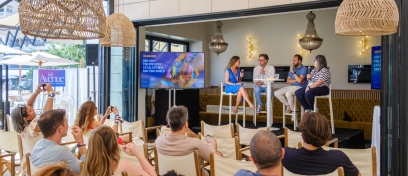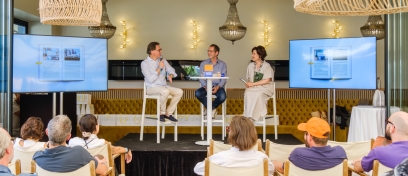Creativity serving the environment: the best green OOH campaigns
SUSTAINABILITY: THE WAVE THAT KEEPS BUILDING
Sustainability isn’t just a trend any more - more and more companies are making it a core part of their strategy. With global consumers actively concerned with environmental issues and advertisers benefiting from a wide range of technologies and creative options, brands have the opportunity to connect with their audience on a common, global issue - helping the environment and their brand image.
Over 80% of participants in a recent global Nielsen study felt strongly that companies should help improve the environment and declared themselves keen to put their money where their mouth is by supporting brands that show authentic commitment to environmental causes. This passion for sustainability isn’t confined to millennials: it’s consistent across generations, genders and regions.

OOH: A 360-DEGREE SOLUTION FOR ECO-FRIENDLY CAMPAIGNS
Out-of-home (OOH) advertising is a powerful platform for environmentally friendly campaigns, taking issues often discussed online and bringing them to the urban environment – giving them a real-world context and enabling advertisers to leverage all five senses for greater impact.
How can OOH advertising use creativity and technology to serve environmental causes?
Brands can leverage the power of OOH through campaigns that create immersive, personalised and one-off experiences. Whereas brands used to use green marketing to increase awareness on environmental issues in the early days of the sustainability trend, they’re now primarily using it to encourage responsible consumer behaviour. And they use OOH campaigns - with their real-life, dominating presence and mass reach - to drive this messaging.Brands can integrate digital out-of-home (DOOH, predicted to account for 24% of revenues by 2021) with mobile technology to create dynamic content (which changes according to variables in the nearby environment such as weather, real-time news and viewers’ eye movements), unleashing a world of experiential possibilities.
Experiential marketing can be particularly beneficial to campaigns with eco-friendly messaging: creatives can use the advertising experience itself to have a positive impact on the surrounding environment, educating passers-by through practical, on-the-go initiatives.
Cities are becoming increasingly connected (physically and digitally) offering a great opportunity for brands to connect with audiences in original ways. This might be through pop-up activations - popular for providing unique encounters and versatility.
We have selected five great examples of environmentally conscious OOH campaigns that forge an emotional connection with consumers and positively impact the environment around them.
McDonald's branches out to help endangered bees
Climate change is endangering the dwindling bee population, essential to the pollination of a wide range of crops vital to our food system.McDonald’s took a stand and set up “bee hotels” behind billboards in Sweden, where 30% of the wild bees’ population is in danger. The main problem is the lack of nests where the animals can live.
The first test was rolled out outside of Stockholm, where six large bee hotels have been mounted on the backside of a billboard with hopes of scaling up the initiative in the future. The signs are available to be ordered by any of McDonald's' Swedish franchises.
Receiving wide praise and coverage, the initiative provided spaces for thousands of bees to rest safely and shed light on the giant’s commitment to sustainability.
Advertiser: McDonald’s
Location: Järfälla (Stockholm)
Duration: April 2019
Format: Large Format – Billboard
Creative Solution: Special-build
A breath of fresh air in one of London’s busiest stations
The BNP Paribas campaign is a breath of fresh air within Marylebone railway station, a key central London transport hub that combines rail services, metro lines and bus routes. The campaign is the result of an ongoing partnership led by BNP Paribas with Airlabs, Chiltern Railways, and JCDecaux.BNP Paribas, whose headquarters are located a short walk from the station, installed six innovative air-filtering systems designed by Airlabs, which JCDecaux incorporated into the station’s advertising furniture, along with consistent branding all over the station to promote the initiative.
The air filtering systems, which received excellent feedback from passengers, can reduce pollution levels within the station by over 95%.
Advertiser: BNP Paribas
Location: Marylebone, London
Duration: 15 October 2018 – ongoing
Format: Indoor advertising furniture
Creative Solution: Special-build, tech, experiential
Feeding urban bees one oasis at a time
In May 2018, in the lead-up to World Bee Day, A1 Telecom drew attention to a recurring issue in urban landscapes that is often overlooked: due to the effect of global warming on flowering time, bees’ food supplies in late summer are often depleted. When bees go hungry, so can humans, since up to a third of the world's food supply depends on them.
To help city-dwelling bees and raise awareness of this problem, telecommunications company A1 Telekom transformed the heart of Slovenian capital Ljubljana into an urban garden of 3,500 honey bee plants for a week. Pedestrians were encouraged to take one of the 12 sorts of plants from street panels to create their own bee forage oasis on a balcony at home and help bees up until the autumn.
The campaign also resonated on social media, reaching over 350,000 users, creating almost 3.500 interactions and gaining 88,330 video views – a great result for a one-week campaign, which illustrates how OOH and online marketing efforts can support each other, and how brands can drive strong audience engagement with green messaging.
Advertiser: A1 Telecom Slovenija
Location: Slovenska cesta
Duration: Summer 2018
Format: Street Furniture
Creative Solution: Special-build, experiential

Waste sorting on the way home
Ikea, at the vanguard of innovative OOH campaigns and a champion of green marketing, raised the issue of recycling with a custom-built tram shelter in Prague that caught the eye with a mini 3D greenhouse on top of the structure.
The greenhouse, part of the retailers’ offer for urban gardeners, drew attention to the tram shelter by attaching bins for waste sorting. Passengers waiting for their tram could take the opportunity to empty their pockets in the recycling bins.
Advertiser: Ikea
Location: Prague, Czech Republic
Duration: 29 March – 11 April 2016
Format: Street Furniture
Creative Solution: Special-build, experiential

Real-time plastic recycling at the bus stop
Surfwear brand O’Neill took customer engagement to the next level by educating Amsterdam residents on the plastic emergency with a simple, real-time recycling exercise.
An O’Neill brand ambassador asked passers-by to take selfies - and subsequently threw their sunglasses into a recycling bin. The ambassador explained that while plastic bottles and sunglasses are both made of the same material, people often just use bottles once before discarding them – which you wouldn’t do with your sunglasses.
The ambassador then took participants to a nearby bus shelter – incorporating a camera and a screen to take selfies, and a 3-D printer - where they received complimentary mini surfboard souvenirs, clever examples of the possibilities for recycled plastics.
Advertiser: O’Neill
Location: Amsterdam
Duration: July 2016
Format: Street Furniture
Creative Solution: Special-build, experiential
The bus shelters purifying central London air
The Body Shop, which has often included environmentally-friendly messaging in its campaigns, partnered with JCDecaux UK, green technology start-up Airlabs and Maxus to incorporate innovative cleaning units into its brand advertising at three bus stops in central London in 2017. The aim of the campaign was to help reduce Londoners' exposure to polluted air, inspire other companies and key stakeholders to get involved in efforts to ensure clean city air and raise awareness of the air-cleaning technology available.
The campaign took place in an area that is both a tourist landmark and a business hub, with large volumes of commuters and other transit users. Airlabs research showed that central London exceeded legal limits of nitrogen dioxide levels multiple times that year.
The air-cleaning technology, neatly integrated into the bus shelter panels, removed pollutants and delivered up to 95% cleaner air, helping protect passengers standing inside the bus stops - who are at high risk from pollution exposure. The clean air that the campaign provided could fill more than 80 buses every day.
Many Londoners were unaware of the air pollution in the area, and the artwork on the side of the air-cleaning filters educated passers-by on its adverse effects on health and wellbeing, as well as its ageing effect on skin.
Advertiser: The Body Shop
Location: Central London
Duration: 22 May – 18 June 2017
Format: Street Furniture
Creative Solution: Special-build, tech, experiential



